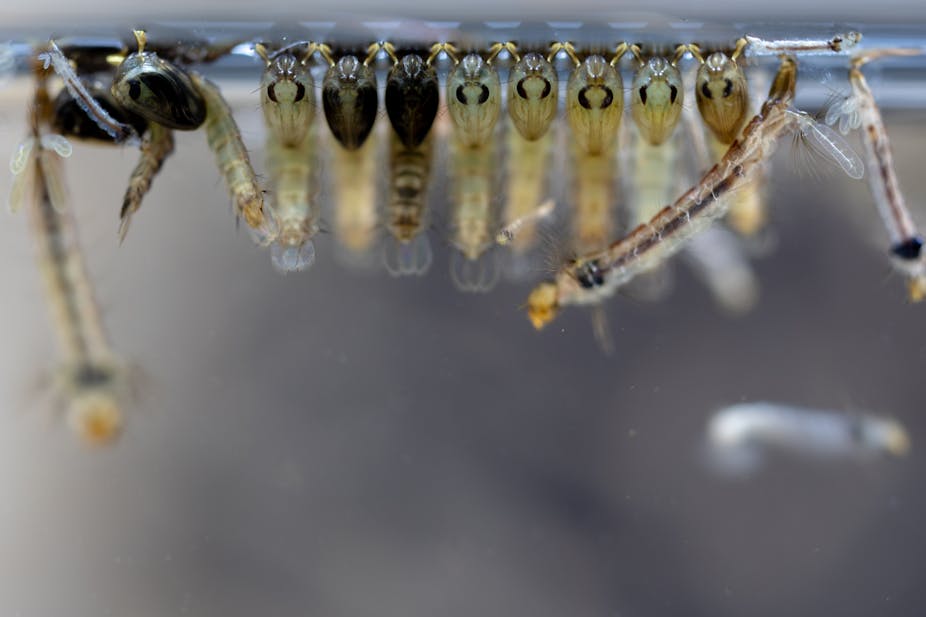Raising Mosquito Larvae for Fish Food
How to Raise Mosquito Larvae for Fish Food

Some fish need to be fed live food, which is often more expensive than flakes or pellets. If you hope to breed your fish, you may have to feed them live food during their mating cycle. Regardless of the reason, you choose to feed your fish live food, raising your own could be more convenient and cost-effective than purchasing it from pet stores. Raising mosquito larvae is extremely simple and can provide nutritious food for your fish free of charge! All it takes is a container to hold water, a little patience, and a watchful eye.
Part 1
Preparing a Friendly Environment for Mosquito Larvae
1. Get a water container for your larvae. There are many container options that you can choose from to grow mosquito larvae. Larger containers will permit you to grow more larvae, but remember that the larvae you don’t harvest will eventually hatch into mosquitos in your yard. Make sure to use a new or clean food-grade container. Do not use one that has held paint, tar, or other chemicals as the chemicals will poison the algae or larva.
- A five-gallon bucket is an excellent choice for your water source, but if you have a large number of fish you intend to feed, you may want to go with something as large a 50-gallon barrel.
- A one-quart container can provide you with enough mosquito larvae to feed most hobbyist’s fish.
- Leave debris that falls into the water. It will add to the bacterial growth mosquito larvae will feed off of.
- Treat the tap water with a dechlorinator that will neutralize the chlorine content that may be present in your tap water.
- Place the bucket under an overhang or dense tree growth to keep it shaded from the sun.
- It’s okay if sunlight reaches the bucket at times, but position it so it does not receive direct sunlight for too much of the day.
- Mosquito eggs will look like tiny rafts of dark brown eggs. These egg rafts tend to hatch within 48 hours.
- When mosquito eggs hatch, they release what looks like abdomens with two antennae. These hatchlings are commonly referred to as “wrigglers” and are the larvae you can feed to your fish.
- If you do not see any eggs in your bucket within a week or two, consider moving it to another part of your yard. The water may be becoming too warm (if in sunlight) or too cold.
Part 2
Feeding Mosquito Larvae to Your Fish
1. Use an eyedropper or small net to catch your larvae. Mosquito larvae are very small, so make sure you purchase a small aquarium net designed to capture tiny aquatic life. Nets designed for brine shrimp will work perfectly. You can also use an eyedropper to capture individual or small groups of eggs or larvae.
- Make sure to transfer the larvae or eggs into your aquarium quickly so they don’t die before your fish can eat them.
- Pouring your water container into your aquarium is not advised, as you may not want to introduce the algae and debris in the mosquito’s water to your tank.
- It’s okay if your fish eat the egg boats before they hatch.
- These eggs will usually hatch within 48 hours of being laid, so you may not find them very often.
- Larvae appear to have antennae which are actually siphon tubes used for breathing.
- Larvae that enters the pupa stage will look as though they have developed a head and will no longer feed on algae. These can be fed to fish, but should otherwise be washed down the drain as it is the last stage before flying.
- To avoid cultivating a swarm of mosquitoes in your yard, purge any larvae your fish don’t eat by pouring the water down the drain.
- Pouring your water out in your yard may not prevent the larvae from becoming full-grown mosquitoes.
- If you used tap water, there may have still been some chlorine present. Chlorine will kill mosquito larvae.
- If your bucket received direct sunlight at some point of the day, it may be becoming too hot for larvae to survive in the water.
Comments
Post a Comment